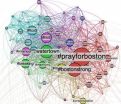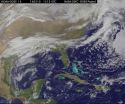(Press-News.org) Trading food involves the trade of virtually embedded water used for production, and the amount of that water depends heavily on the climatic conditions in the production region: It takes, for instance, 2.700 liters of water to produce 1 kilo of cereals in Morocco, while the same kilo produced in Germany uses up only 520 liters. Analyzing the impact of trade on local water scarcity, our scientists found that it is not the amount of water used that counts most, but the origin of the water. While parts of India or the Middle East alleviate their water scarcity through importing crops, some countries in Southern Europe export agricultural goods from water-scarce sites, thus increasing local water stress.
"Agriculture accounts for 70 percent of our global freshwater consumption and therefore has a huge potential to affect local water scarcity," lead author Anne Biewald says. The amount of water used in the production of agricultural export goods is referred to as virtual water trade. So far, however, the concept of virtual water could not identify the regional water source, but used national or even global averages instead. "Our analysis shows that it is not the amount of water that matters, but whether global food trade leads to conserving or depleting water reserves in water-scarce regions," Biewald says.
Combining biophysical simulations of the virtual water content of crop production with agro-economic land-use and water-use simulations, the scientists were able for the first time to determine the positive and negative impacts on water scarcity through international trade of crops, livestock and feed. The effects were analyzed with high resolution on a subnational level to account for large countries like India or the US with different climatic zones and relating varying local conditions regarding water availability and water productivity. Previously, these countries could only be evaluated through national average water productivity. "Local water scarcity is reduced through imports of agricultural goods, and therefore saving regional agricultural production particularly in parts of India, Morocco, Egypt and Pakistan. But scarcity is exacerbated by exports in parts of Turkey, Spain, Portugal, Afghanistan and the US," Biewald says. Despite the fact that Europe alone exports virtual water in food crops worth 3.1 billion US-Dollars, the scientists found that international trade of food crops today globally accounts for water savings worth 2.4 billion US-Dollars.
The study, focusing on data of the year 2005, shows that trade has a considerable impact on agricultural production. Trade reduces global crop production and area due to regionally different livestock production efficiencies: one kilo of beef for instance can be produced with much less input feed in the US than in Africa, so it might be more economical for the world to have regions specializing in certain products and exporting them to others. "In contrast to popular perception, global food trade and the related virtual water flows indeed offer the possibility of relieving water stress and making global water use more efficient," co-author Hermann Lotze-Campen, co-chair of PIK´s research domain Climate Impacts and Vulnerabilities, says. "When it comes to the implementation of policy instruments which affect global trade – such as trade liberalization, import taxes or agricultural subsidies –, decision makers have to take into account the indirect effects on water as well. To connect international food trade to regional water scarcity can contribute to advance this debate."
INFORMATION:
Article: Biewald, A., Rolinski, S., Lotze-Campen, H., Schmitz, C., Dietrich, J.P (2014): Valueing the impact of trade on local blue water. Ecological Economics, Volume 101 [10.1016/j.ecolecon.2014.02.003]
Weblink to the article: http://www.sciencedirect.com/science/article/pii/S0921800914000391
For further information please contact:
PIK press office
Phone: +49 331 288 25 07
E-Mail: press@pik-potsdam.de
Twitter: @PIK_Climate
Global food trade can alleviate water scarcity
2014-03-18
ELSE PRESS RELEASES FROM THIS DATE:
Using big data to identify triple-negative breast, oropharyngeal, and lung cancers
2014-03-18
Researchers at Case Western Reserve University and colleagues used "big data" analytics to predict if a patient is suffering from aggressive triple-negative breast cancer, slower-moving cancers or non-cancerous lesions with 95 percent accuracy.
If the tiny patterns they found in magnetic resonance images prove consistent in further studies, the technique may enable doctors to use an MRI scan to diagnose more aggressive cancers earlier and fast track these patients for therapy. Their work is published online in the journal Radiology at http://pubs.rsna.org/doi/full/10.1148/radiol.14131384. ...
Strongest evidence yet of 2 distinct human cognitive systems
2014-03-18
BUFFALO. N.Y. — Cognitive scientists may have produced the strongest evidence yet that humans have separate and distinct cognitive systems with which they can categorize, classify, and conceptualize their worlds.
"Our finding that there are distinct, discrete systems has implications for the fields of child development and cognitive aging," says lead researcher, cognitive psychologist J. David Smith, PhD, of the University at Buffalo.
"These distinct systems may have different developmental courses as the cortex matures," he says, "meaning that children may categorize ...
Ipilimumab in advanced melanoma: Added benefit for non-pretreated patients not proven
2014-03-18
The German Institute for Quality and Efficiency in Health Care (IQWiG) already assessed the added benefit of ipilimumab in advanced melanoma in 2012. A considerable added benefit was found for patients who had already received previous treatment. In the new dossier compiled by the drug manufacturer, the drug was now compared with the appropriate comparator therapy dacarbazine specified by the Federal Joint Committee (G-BA) also for non-pretreated patients.
Again, the manufacturer claimed a noticeable gain in survival time and thus an added benefit. This time, IQWiG did ...
Scientists using UNH detector illuminate cause of sun's 'perfect storm'
2014-03-18
DURHAM, NH –– In a paper published today in Nature Communications, an international team of scientists, including three from the University of New Hampshire's Space Science Center, uncovers the origin and cause of an extreme space weather event that occurred on July 22, 2012 at the sun and generated the fastest solar wind speed ever recorded directly by a solar wind instrument.
The formation of the rare, powerful storm showed striking, novel features that were detected by a UNH-built instrument on board NASA's twin-satellite Solar TErrestrial RElations Observatory (STEREO) ...
New airborne GPS technology for weather conditions takes flight
2014-03-18
GPS technology has broadly advanced science and society's ability to pinpoint precise information, from driving directions to tracking ground motions during earthquakes. A new technique led by a researcher at Scripps Institution of Oceanography at UC San Diego stands to improve weather models and hurricane forecasting by detecting precise conditions in the atmosphere through a new GPS system aboard airplanes.
The first demonstration of the technique, detailed in the journal Geophysical Research Letters (GRL), is pushing the project's leaders toward a goal of broadly implementing ...
Pitt study challenges accepted sepsis treatment
2014-03-18
PITTSBURGH, Mar.14, 2014 – A structured, standardized approach to diagnose and treat sepsis in its early stages did not change survival chances for people who develop this deadly condition, according to a national, randomized clinical trial led by experts at the University of Pittsburgh School of Medicine.
Their findings, available online and published in the May 1 edition of the New England Journal of Medicine, could change the way sepsis is diagnosed and treated. Each year, sepsis, the body's response to severe infections, kills more people than breast cancer, prostate ...
Hold that RT: Much misinformation tweeted after 2013 Boston Marathon bombing
2014-03-18
It takes only a fraction of a second to hit the retweet button on Twitter. But if thousands of people all retweet at once, a piece of information 140 characters long can go viral almost instantly in today's Internet landscape.
If that information is incorrect, especially in a crisis, it's hard for the social media community to gain control and push out accurate information, new research shows.
University of Washington researchers have found that misinformation spread widely on Twitter after the 2013 Boston Marathon bombing despite efforts by users to correct rumors ...
Satellite movie shows a Mid-Atlantic St. Patrick's Day snow
2014-03-18
The green of St. Patrick's Day in the Mid-Atlantic was covered by white snow as a result of a late winter snow storm. The covering of the green was captured in a movie made at NASA using NOAA's GOES satellite data.
The winter storm dropped snow totals from 6" to 12" of snow from Baltimore, Md. to Richmond, Va. The storm arrived during the evening of March 16 and continued through March 17. As of 1 p.m. EDT, light bands of snow continued to fall throughout the Washington, D.C. area.
NOAA's GOES-East satellite captured the path the storm took through the Mid-Atlantic ...
Health gap between adult survivors of childhood cancer and siblings widens with age
2014-03-18
Adult survivors of childhood cancer face significant health problems as they age and are five times more likely than their siblings to develop new cancers, heart and other serious health conditions beyond the age of 35, according to the latest findings from the world's largest study of childhood cancer survivors. St. Jude Children's Research Hospital led the research, results of which appear in the March 17 issue of the Journal of Clinical Oncology.
The federally funded Childhood Cancer Survivor Study (CCSS) found that the health gap between survivors and their siblings ...
'Breaking bad': Insect pests in the making
2014-03-18
Of thousands of known species of Drosophila fruit flies, just one is known as a crop pest, depositing eggs inside ripening fruit so its maggots can feed and grow. New research from the University of California, Davis, shows the similarities and crucial differences between this pest and its close relatives — and that one related fly has potential to also become a pest.
Drosophila flies, found worldwide, lay their eggs in rotting fruit. Drosophila suzukii, also referred to as "spotted-wing Drosophila" because the male has large black blotches on his wings (as do males of ...




